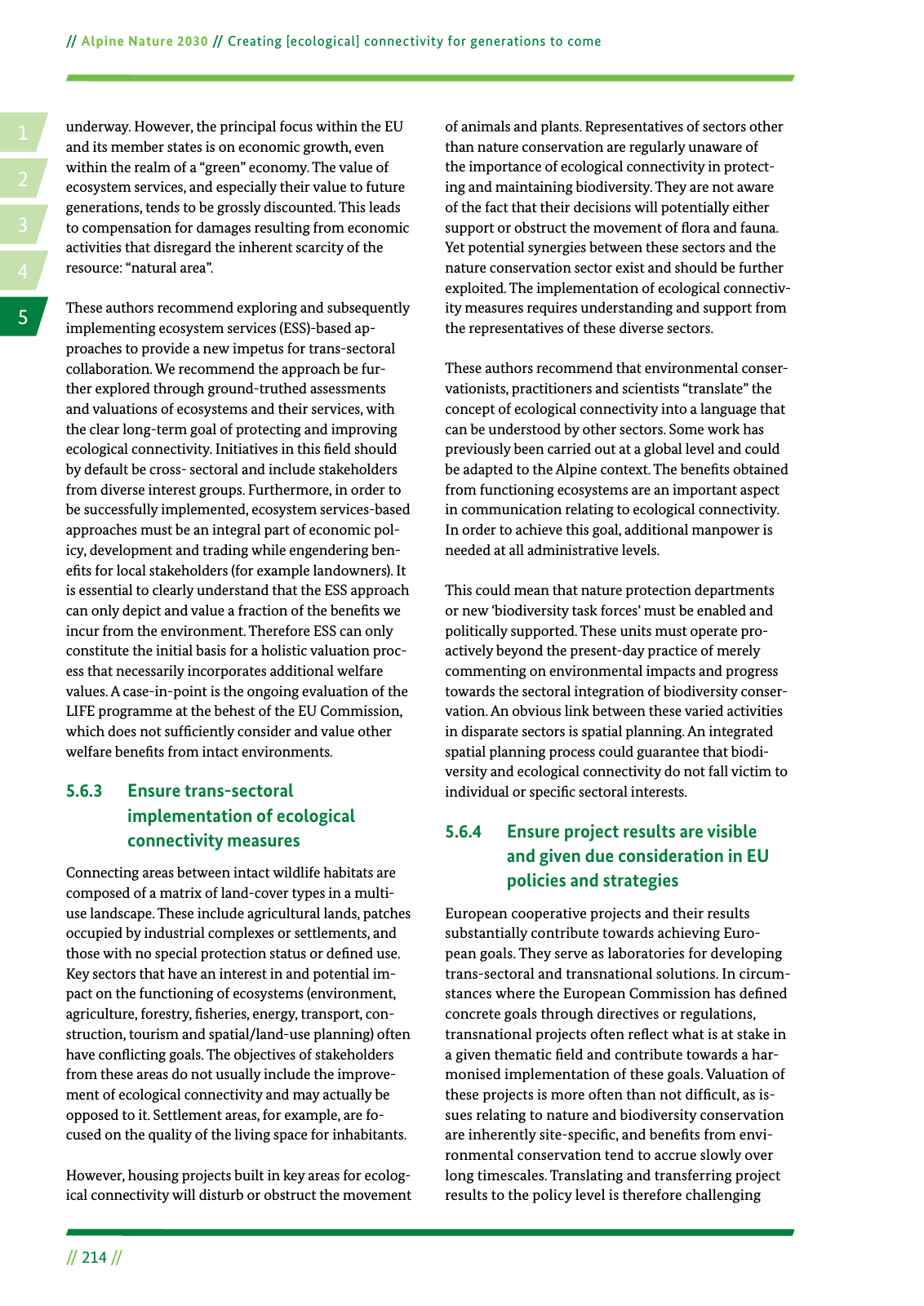14 2 5 3 Alpine Nature 2030 Creating ecological connectivity for generations to come 214 underway However the principal focus within the EU and its member states is on economic growth even within the realm of a green economy The value of ecosystem services and especially their value to future generations tends to be grossly discounted This leads to compensation for damages resulting from economic activities that disregard the inherent scarcity of the resource natural area These authors recommend exploring and subsequently implementing ecosystem services ESS based ap proaches to provide a new impetus for trans sectoral collaboration We recommend the approach be fur ther explored through ground truthed assessments and valuations of ecosystems and their services with the clear long term goal of protecting and improving ecological connectivity Initiatives in this eld should by default be cross sectoral and include stakeholders from diverse interest groups Furthermore in order to be successfully implemented ecosystem services based approaches must be an integral part of economic pol icy development and trading while engendering ben e ts for local stakeholders for example landowners It is essential to clearly understand that the ESS approach can only depict and value a fraction of the bene ts we incur from the environment Therefore ESS can only constitute the initial basis for a holistic valuation proc ess that necessarily incorporates additional welfare values A case in point is the ongoing evaluation of the LIFE programme at the behest of the EU Commission which does not suf ciently consider and value other welfare bene ts from intact environments 5 6 3 Ensure trans sectoral implementation of ecological connectivity measures Connecting areas between intact wildlife habitats are composed of a matrix of land cover types in a multi use landscape These include agricultural lands patches occupied by industrial complexes or settlements and those with no special protection status or de ned use Key sectors that have an interest in and potential im pact on the functioning of ecosystems environment agriculture forestry sheries energy transport con struction tourism and spatial land use planning often have con icting goals The objectives of stakeholders from these areas do not usually include the improve ment of ecological connectivity and may actually be opposed to it Settlement areas for example are fo cused on the quality of the living space for inhabitants However housing projects built in key areas for ecolog ical connectivity will disturb or obstruct the movement of animals and plants Representatives of sectors other than nature conservation are regularly unaware of the importance of ecological connectivity in protect ing and maintaining biodiversity They are not aware of the fact that their decisions will potentially either support or obstruct the movement of ora and fauna Yet potential synergies between these sectors and the nature conservation sector exist and should be further exploited The implementation of ecological connectiv ity measures requires understanding and support from the representatives of these diverse sectors These authors recommend that environmental conser vationists practitioners and scientists translate the concept of ecological connectivity into a language that can be understood by other sectors Some work has previously been carried out at a global level and could be adapted to the Alpine context The bene ts obtained from functioning ecosystems are an important aspect in communication relating to ecological connectivity In order to achieve this goal additional manpower is needed at all administrative levels This could mean that nature protection departments or new biodiversity task forces must be enabled and politically supported These units must operate pro actively beyond the present day practice of merely commenting on environmental impacts and progress towards the sectoral integration of biodiversity conser vation An obvious link between these varied activities in disparate sectors is spatial planning An integrated spatial planning process could guarantee that biodi versity and ecological connectivity do not fall victim to individual or speci c sectoral interests 5 6 4 Ensure project results are visible and given due consideration in EU policies and strategies European cooperative projects and their results substantially contribute towards achieving Euro pean goals They serve as laboratories for developing trans sectoral and transnational solutions In circum stances where the European Commission has de ned concrete goals through directives or regulations transnational projects often re ect what is at stake in a given thematic eld and contribute towards a har monised implementation of these goals Valuation of these projects is more often than not dif cult as is sues relating to nature and biodiversity conservation are inherently site speci c and bene ts from envi ronmental conservation tend to accrue slowly over long timescales Translating and transferring project results to the policy level is therefore challenging

Hinweis: Dies ist eine maschinenlesbare No-Flash Ansicht.
Klicken Sie hier um zur Online-Version zu gelangen.
Klicken Sie hier um zur Online-Version zu gelangen.